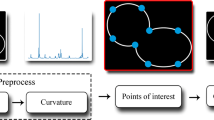Abstract
Splitting touching cells is important for medical image processing and analysis system. In this paper, a novel strategy is proposed to separate ellipse-like or circle-like touching cells in which different algorithms are used according to the concave-point cases of touching domains. In the strategy, a concave-point extraction and contour segmentation methods for cells in series and in parallel are used for the images with distinct concave points, and an improved watershed algorithm with multi-scale gradient and distance transformation is adopted for the images with un-distinct or complex concave points. In order to visualize each whole cell, ellipse fitting is used to process the segments. Experimental results show that, for the cell images with distinct concave points, both of the two algorithms can achieve good separating results, but the concave-point based algorithm is more efficient. However, for the cell images with unobvious or complex concave points, the improved watershed based algorithm can give satisfying segmenting results.
Similar content being viewed by others
References
Shirin N I, Atefeh M, Ali M N. A new approach for touching cells segmentation. In: Proceedings of the 2008 International Conference on Biomedical Engineering and Informatics. 2008, 816–820
Mussio P, Pietrogrande M, Bottoni P. Automatic cell counter in digital images of liver tissue sections. In: Proceedings of the 4th IEEE Symposium on Computer-Based Medical Systems. 1991, 153–160
Ali S, Abdullah Z, Rosalina A. Combining boundary and skeleton in formation for convex and concave points detection. In: Proceedings of the 7th International Conference on Computer Graphics, Imaging and Visualization. 2010, 113–117
Wang W, Song H. Cell cluster image segmentation on form analysis. In: Proceedings of the 3rd International Conference on Natural Computation. 2007, 833–836
Bai X, Sun C, Zhou F. Touching cells splitting by using concave points and ellipse fitting. In: Proceedings of the 2008 Digital Image Computing: Techniques and Applications. 2008, 271–278
Grau V, Mewes A, Alcaniz M, Kikinis R. Improved watershed transform for medical image segmentation using prior information. IEEE Transactions on Medical Imaging, 2004, 23(4): 447–458
Zhang X J, Sun W R, Zhong Z H. A new algorithm for watershed segmentation of cells in marrow. In: Proceedings of the 27th Annual International Conference of the Engineering in Medicine and Biology Society. 2005, 6456–6459
Liu Y, Zhao Q. An improved watershed algorithm based on multi-scale gradient and distance transformation. In: Proceedings of the 3rd International Congress on Image and Signal Processing. 2010, 8: 3750–3754
Jumaat A K, Rahman W, Ibrahim A, Mahmud R. Comparison of balloon snakes and GVF snakes in segmenting masses from breast ultrasound images. In: Proceedings of the 2nd International Conference on Computer Research and Development. 2010, 505–509
Du X, Bui T. A new model for image segmentation. IEEE Signal Process Letters, 2008, 15: 182–185
Zhang Q, Min L, Zhang J, Zhang M. Automatic liver segmentation scheme forMRI images based on cellular neural networks. China Communications, 2012, 9(9): 89–95
Wu H S, Barba J, Gil J. A parametric fitting algorithm for segmentation of cell images. IEEE Transations on Biomedical Engineering, 1998, 45(3): 400–407
Kharma N, Moghnieh H, Yao J, Guo Y. Automatic segmentation of cells from microscopic imagery using ellipse detection. IET Image Processing, 2007, 1(1): 39–47
Author information
Authors and Affiliations
Corresponding author
Additional information
Hong Song received her PhD degree in computer science and technology from Beijing Institute of Technology in 2003. She is currently an associate professor in the School of Software, Beijing Institute of Technology, China. Her current research interests include image processing, machine vision, and computer graphics.
Qingjie Zhao received her PhD degree in computer science and technology from Tsinghua University in 2003. She is currently a professor in the School of Computer Science and Technology, Beijing Institute of Technology, China. Her current research interests include image processing, machine vision, and computing intelligence.
Yinghong Liu received her MS degree from School of Computer Science and Technology, Beijing Institute of Technology in 2012. She now works in Lenovo, China.
About this article
Cite this article
Song, H., Zhao, Q. & Liu, Y. Splitting touching cells based on concave-point and improved watershed algorithms. Front. Comput. Sci. 8, 156–162 (2014). https://doi.org/10.1007/s11704-013-3130-2
Received:
Accepted:
Published:
Issue Date:
DOI: https://doi.org/10.1007/s11704-013-3130-2




